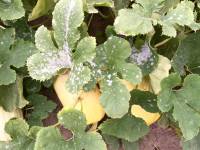Table of Contents
Powdery mildew
Bad fungi
One things many curcubit family members have in common is a susceptibility to powdery mildew. In 2014 we had a catastrophic outbreak of this fungus. At that time I thought the fungus must be endemic to the soil. This year I studied up and found a strategy to thwart it.
Fungi that generate powdery mildew on cucurbits are prolific in the Fall City garden. In 2014 these fungi decimated pumpkin and squash.
Choice varieties
The most effective approach is to find varieties that are not susceptible to these fungi. I've found these summer and winter squash to be highly resistant: Dark Star zucchini, Sunburst Scallop yellow squash, REBA acorn squash and Butterbush squash.
But there are others that don't offer a resistant variety. So we begin with propagation.
Heat and light
We used heat mats and grow lights in a greenhouse (see the pages on propagation) to germinate seeds and encourage strong, healthy plants from the start.
Milk foliar spray
Once transplants are in the ground, every ten days or so I sprayed the leaves lightly with a 10% solution of skim milk in water. The solution is 1 part skim milk (any variety will do, but butter fat isn't the critical ingredient) and 9 parts water.
Soil remineralization
This balancing of minerals and nutrients in the soil (see the page on remineralization) is said to enhance plant health and limit effects of fungus and insects.
Healthy leaves
Through most of the season all the cucurbits had remarkably healthy leaves. Cloudy, moist weather in late August brought on the powdery mildew in a couple of varieties.
Prevention
For the 2015 season I wanted to thwart these guys and prevent powdery mildew, so I studied up.
I chose an organic mix of 10% skim milk in water with just a touch of bicarbonate of soda. Scientific evidence says something in the milk enhances the resistance of cucurbits to these fungi and the bicarbonate of soda alters the pH of moisture on the leaves to inhibit proliferation of powdery mildew. I began with one-half teaspoon of baking soda (bicarbonate of soda), however, this seemed to “burn” the leaves of cucumbers so I reduced it to one-quarter teaspoon.
Did it work?
Through the middle of August there was no sigh of powdery mildew. The leaves of all the cucurbits were the healthiest I've ever grown. Suddenly, the white spots showed up on a couple of leaves of a yellow squash plant. I removed them immediately. Next I saw the dreaded powder on leaves of a spaghetti squash plant. I removed them and continued the foliar milk spray.
Treatment
 All leaves seemed clear for a week or so. Then there was an snowy epidemic on both yellow squash and spaghetti squash plants. More study. I prepared a mixture of 10% hydrogen peroxide and milk with the soda and sprayed it on the leaves. This seemed to hold the mildew at bay.
All leaves seemed clear for a week or so. Then there was an snowy epidemic on both yellow squash and spaghetti squash plants. More study. I prepared a mixture of 10% hydrogen peroxide and milk with the soda and sprayed it on the leaves. This seemed to hold the mildew at bay.
At the time the zucchini (Dark Star) and Sweet REBA (Resistant Early Bush Acorn) acorn squash were unaffected although they were neighbors.
I could have let the summer squash go, but there were a dozen large spaghetti squash on the vine that weren't mature yet and I wanted to be able to harvest them.
The mildew isn't gone, but it is lessened. So I continue the treatment hoping I win enough time for the squash to ripen.
Bottom line
Mid-August we had cloudy, moist weather. Immediately, powdery mildew flourished. I treated again on two occasions with a peroxide/milk spray, but the yellow squash and the spaghetti squash were so heavily involved that there was no reversing the fungi. I harvested what was mature enough and put the vines in yard waste to be hauled away.
The Dark Star zucchini and the REBA acorn squash remained untouched.
2016
This year almost all the cucurbits at the garden were affected, especially the pumpkins and some of the zucchini (planted some Burpee Fordhook, which aren't as resistant as the Dark Star).
Because the pie pumpkins were severely affected and they weren't ripening well I used a 2% mixture of a copper-based fungicide, which appears to have given the leaves a chance to continue photosynthesis and serving the pumpkins. Milder measures (application of the 10% milk solution) had been unsuccessful.
So, I hoped that the 2% copper fungicide was a way to ward off powdery mildew until the fruit matures. It took repeated applications to limit the powdery mildew, but it was never completely successful. Ultimately, I got a good harvest of pumpkins.
Apparently, this is the strategy for commercial growers with cucurbits that are subject to mildew: attempt to hold down the amount of powdery mildew until the fruit can be harvested. But cool, damp weather early in August challenges this strategy in the Pacific Northwest.
Next year?
Because powdery mildew is such a persistent issue at the Fall City garden I don't plan to grow cucurbits there for at least a couple of years. This raises the question of just what can I grow there. Even though root crops have been problematic I will probably focus on them and greens next year.
